Recently, Magic the Gathering made the contentious choice to finally remove “tribal” from its parlance. Beginning in 2002 with the Onslaught block, R&D introduced the term tribal to mean, as Mark Rosewater put it at first, “any [card] that references a particular creature race[…] or allows you to select a particular race.” Before that point, while there had been cards that referenced a creature’s type (a mostly flavorful designation like ‘elf’, ‘soldier’, or ‘dragon’), no full set or block had been designed around a creature’s type mattering. With the release of Lorwyn in 2007, the term was codified in the rules as the name of a supertype which allowed even non-creature cards to have creature types. Now, in 2023, the term’s being retired entirely. In this article, I’ll take a deep dive into the history of what tribal meant to Magic the Gathering, why it needs to be retired, and what comes next.
Cards that benefited a certain creature type were some of the most popular and enduring features of Alpha, the first Magic the Gathering set ever released. Nicknamed lords (after the creature type assigned to Goblin King, Lord of Atlantis, and Zombie Master, the first of these creatures), they inspired players to fill decks with creatures that fit a theme. Legends was perhaps the earliest set to mechanically care about a creature type, but looking back on those cards today, every card with that ‘legend’ typing has received errata making it a legendary creature of a different type, scattering the type to the winds. The theme was explored in Fallen Empires, but overshadowed by the set’s reputation as overproduced garbage not worth the cardboard it was printed on. However, it had not received a name in R&D lingo until Onslaught, where, as Mark Rosewater put it,
““Race matters” is sort of clunky. Perhaps we need a snappy word for “race matters”. Ooh, “tribal” sounds cool.”
Mark Rosewater, in Tribal’s in Your Court (Sep 23, 2002)
Notice anything? Before the introduction of tribal, a creature’s type was being referred to as its race. The almost comically poorly phrased ‘race matters’ theme couldn’t be presented that way to the players. This was the same set that featured hook-nosed goblins whose lives even the supposed heroes agreed were worth less than nothing and a sinister cabal dripping with overtones of blood libel, as well as forest dwelling elves who played into the ‘noble savage’ trope, so there’s no denying that their idea of ‘race matters’ played into the same racist tropes that fueled fantasy design at the time. (For more information on the racism inherent in the trope of fantasy races, check out this great article on Wired that focuses on Dungeons and Dragons.) By encoding the idea of genetic determinism into the objective reality of the world they created, Magic created a legacy of racism that’s hard to uproot.
And the legacy of encoding racism into the world of Magic the Gathering would continue. Not only would new worlds continue to introduce stereotypes that wouldn’t look out of place on propaganda posters, but tribal became a core part of Magic’s parlance and players began to clamor for more worlds where factions divided along racial boundaries. As Eighth Edition split types into ‘races’ and ‘classes’, it became clear that ‘race’ types like goblins and elves were loved, and ‘class’ types like Kamigawa’s samurai and ninja or even Zendikar’s characteristic allies were ignored. The message was clear–Magic was hungry for tribal elements, where tribal meant conflict sparked by genetic determinism and buoyed by isolationism, nationalism, and fantasy racism.
The Lorwyn/Shadowmoor block is considered the great triumph of tribal design–four sets designed entirely around creature type mechanics. Two new card types were introduced in these sets that had been teased in Future Sight. One of these, Planeswalkers, is so popular that it’s become the face of Magic the Gathering. The other, “Tribal”, is so obscure that even enfranchised players may not have heard of it. It’s a retired mechanic that allows non-creature cards to have creature types. (This is probably where I lose non-players of MTG. Stay put! We’ll be out of the weeds soon enough.) This meant that even intangible spells and lifeless artifacts could be embroiled in the racial conflict that embroiled the plane of Lorwyn.
And conflict there was in abundance–Lorwyn’s nine tribes live in ethnostates that resent each other, with the explicitly genocidal elves holding the most power. They justify their slaughter of those they consider lesser by claiming that they are upholding beauty and removing ‘eyeblights’, reminiscent of the way that European beauty standards were used to justify eugenics. While they are the villains of the Lorwyn part of the block, everything changes when the plane becomes Shadowmoor, and this obsession with beauty is reimagined as the only saving grace for a “corrupted” world. Although official WOTC accounts of the Lorwyn/Shadowmoor era of R&D are hard to find due to the woeful state of the official website, the fan wiki describes the change thus: “What races have survived the change have been thoroughly altered by the tainted darkness covering Shadowmoor. In particular, the demeanor of each race has taken a turn for the worse.” So for those keeping score, the game has introduced an evil represented by darkness, which corrupts the various races in a genetically deterministic world, and they have to be saved by the standards of beauty that had been used to justify genocide. This is the great triumph of ‘race matters’ in the story and mechanics of Magic the Gathering, and it tells a chilling story, all under the same name as used by real-life Indigenous groups to describe their systems of governance, a name that was picked because it sounded cool.
As Wizards of the Coast has made their way into the twenty-first century and finally adopted basic awareness that racism was a problem, they’ve figured out that they made a huge mistake. People have begun to feel more comfortable calling out the overt racism in their settings and design philosophies, and to their credit, they have walked it back. Goblins, orcs, elves, and other types whose designs have been based on racial stereotypes since their introduction have been diversified and given more understanding, and it’s become more clear that in the world of Magic, racism is objectively evil. Characters like Huatli and Saheeli advocate for breaking down racial boundaries and embracing multiculturalism. And with this new understanding and clarity in-universe comes out of universe changes as well, working towards having diversity in the writer’s room and designer’s room. Though we’re still seeing embarrassing blunders like having the only new main character in a precolonial South American culture being a ghost in a poncho only known as Abuelo, WOTC is slowly doing better–and that means ditching the ‘race matters’ ideology.
Now, this is not going to be the end of creature types mattering mechanically. I’m not taking away your favorite toys, and neither is Mark Rosewater, no matter how mad you are about terminology changing. ‘Creature type matters’ is a rich and promising design vein that will never run dry as long as WOTC can introduce new settings with new creature types to support, and it’s popular, profitable, and plays well. But if it’s going to keep going, it can’t keep being a top-down (R&D slang for aesthetics-first) mechanic founded on genetic determinism among ethnonationalist “tribes”. The term “tribal” in MTG carries a painful history of racism. It has to go. But typal carries no such baggage. It refers to bottom-up design (R&D slang for mechanics-first) centered around creature types. It welcomes the potential of ‘class’ types, not just ‘race’ types. It is clinical, yes, but R&D has every right to be clinical behind closed doors, and frankly MTG’s creature type philosophy needs a doctor.
But what about when the doors are open? What of the neglected child, Tribal-the-supertype, and the fifty-five cards from Lorwyn to Modern Horizons 2 that anchor it in the game’s sordid history? Well, the mechanic is being renamed to Kindred, and I actually like that too. Most importantly, it nods to a handful of real-life organizations, but does not tie the supertype’s design and aesthetics to any particular ethnic communities in real life, and while it doesn’t connote quite as much potential for class type designs, that’s hard to do flavorfully. The word ‘Kindred’ has been used on typal designs in the past. The only real issue I have with the change is that perhaps the only significant Kindred card, Bitterblossom, was recently reprinted in several gorgeous printings with the word Tribal on them, and is unlikely to be reprinted again until its price rises back above $30 or $50, and may never be available with the WOE anime-inspired art and the proper typeline. Other cards playable only in commander or not even there, like Veteran’s Armaments or Summon the School, may never be reprinted with the correct type line. While I am personally comfortable playing cards with this type on them, knowing that it was an indelible part of this game’s history and one that was eventually recognized to be a mistake, others might not be. I’d love to see reprints of Kindred cards, even and especially the kind of useless ones, in Secret Lair printings with art by BIPOC artists–not just guests, but BIPOC within WOTC like Winona Nelson.
The renaming of Kindred doesn’t mean we’ll ever see the mechanic again in premier products, but I have hope that, in the right context, it has potential. So here are some original designs with Kindred that tie into the potential the Omenpaths open for multiculturalism, showing members of a type from different planes finding common ground both cultural and mechanical.
Warning: Original, Unsolicited, Designs Ahead
My first design is probably my favorite of the bunch–it showcases a class type, and two planes with different interpretations of that type, as well as having an ability that works with other kindred cards of the type, not just creatures. It also introduces the way that several of these cards will use hybrid mana to represent multiculturalism.
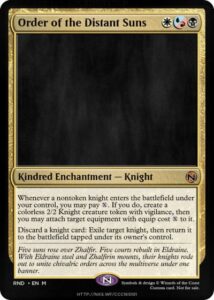
The Order of the Distant Suns brings together WBR knight typal from original Eldraine and WUB knight typal from the recent March of the Machines, and it can be played with a manabase suited to either. It cares about knights entering the battlefield, the most common trigger for knight abilities in MOM, and benefits from equipment, just as knights did in ELD. The flicker ability allows rebuying the enter the battlefield trigger, at the cost of discarding a knight card, which might be kindred cards like this one or creature cards. The cost of 3 mana may be a little low (I also considered 4 mana), but the fact that it can only add to the board on the turn you play it if you also discard a knight to flicker a knight you already have seems awkward enough not to need nerfing from the start. This falls right where I want these cards to: hypothetically playable in exactly the right standard, but right at home in commander. I’ll admit the hybrid mana makes it awkward in commander, but I’m of the opinion that hybrid effects should be playable in decks with only one of the colors anyway, so if you’re not, just imagine this set includes a WUBR knight commander.
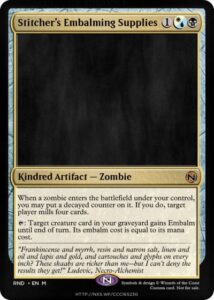
Stitcher’s Embalming Supplies brings together the horrifying skaabs of Innistrad and the placid mummies of Amonkhet. Decayed is one of the most fascinating keywords of recent Magic, and placing keyword counters on tokens is such useful technology, that this fell together pretty easily. (Note that you can decay your original zombies, I just imagine it would be used most on tokens.) I wanted the card to work even in eternal formats like Commander where Embalm options would be very limited even if we returned to Amonkhet, so I gave it the ability from the Naktamun plane card to add embalm to cards in the graveyard. The last thing I decided on was the benefit for decaying your zombies–milling four seems like a good choice to either fill your graveyard quickly with embalmable options or mill out opponents, but it might need to go down to two. The shout-out to kindred here is that non-creature zombies have nothing to lose from becoming decayed, letting you get that benefit for free. The flavor here is something I really like–while the skaaberen of Innistrad have learned to create long-lasting, intelligent, mummies in the way they do on Amonkhet, they know that they still can make shortcuts in the process to do it quickly, sloppily, and most importantly for any Innistradi scientist, insanely.
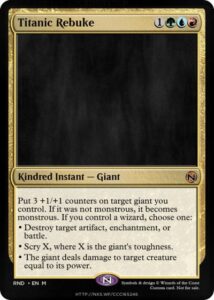
Titanic Rebuke was my attempt at a kindred instant–bringing together the monstrous giants of Theros and the arcane giants of Kaldheim. Neither group is really that well fleshed out mechanically or in the story, but that’s okay. Titanic Rebuke nods to the Theros mechanic of monstrosity, turning on abilities on Theros giants with the ability, of which I found a fair amount. (It does prevent you paying their monstrosity costs, but since those are usually eye-wateringly expensive, think of it as a discount.) Four mana at instant speed for permanent giant growth is super dubious, but provided you fulfill the Kaldheim themed requirement of having a wizard, you also get something worth 3ish mana: a disenchant that hits battles (hinting that battles are in whatever hypothetical set this is from), a humongous scry, or a punch effect that’s definitionally never worse than a lightning strike. This isn’t my favorite design of the group, but kindred cards that don’t stick around are hard to do without just saying “stapling ‘goblin’ onto lightning strike costs one mana extra”, and if kindred ever comes back, the absolute worst thing it could possibly be is boring.
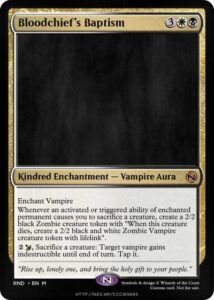
The vampires on Zendikar are dying out, and the vampires on Ixalan are here to extend their “benevolent” influence. Bloodchief’s Baptism imagines a Zendikari bloodchief joining the Legion of Dusk, their sacrifices raising thrulls who follow them into the Legion and eventually become true vampires in their own right. Like in Lost Caverns of Ixalan, sacrifice releases the mighty vampire within, which is a slightly buffer version of the iconic Elenda vampire with some thrull flavor. This aura can make its host indestructible, which gets extra important considering you could chain these auras enchanting another copy of themselves, but (discounting shenanigans) if the creature or kindred at the bottom is removed the whole stack is lost. However, it isn’t meant to be an ideal target for itself, hence why it’s an expensive sacrifice outlet that doesn’t add to the board, gain life, or generate card advantage. With the right infinite sac outlet (like Viscera Seer), though, it can go infinite, making it a killer piece for a vampire aristocrat deck. It might even need to cost more, but I’ve started it at 5 mana, largely pricing it out of constructed formats where you’re unlikely to be able to hold up the mana for the sacrifice ability on the turn you play it.
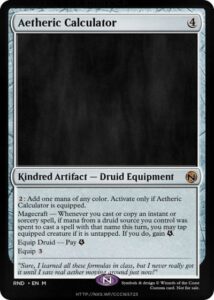
Aetheric Calculator is my attempt at a colorless kindred artifact that’s still connected to a type deeply entwined with its color. It represents the Quandrix mages of Strixhaven learning from the druids of Kaladesh, which would ideally be more obvious through art that combines fractals and aetheric swirls in a gorgeous and otherworldly model, but I don’t really do the MTG art style and this post is late enough. I was very scared and excited to tackle energy, especially on an equipment, but the general idea is to provide a repeated source of energy that still makes you jump through hoops. Once you generate mana with your druids (including this card, which in a pinch can filter mana to trigger its magecraft ability), you can tap the equipped creature to get your energy counter. If you have extra energy, you can put this on a druid on the cheap. This is either underpowered or breaks a Modern deck I’ve never heard of, which means I know about as much as Wizards did when they introduced energy, but I think it’s so flavorful for Strixhaven meets Kaladesh that I couldn’t help but show it off too.
Thanks to everyone who stuck with me for this late, extra long post! This change is one of the most important pieces of news I’ve seen in a while about a game that means a lot to me, and I’m excited to share some of my original designs too.

Hey! I’m the guy who asked about the relevance of the tribal renaming in MaRo’s blog. Nice read; thank you.
(By the way, your card designs don’t all quite work within the rules. If you want to make them fully playable, hit me up at this email!)